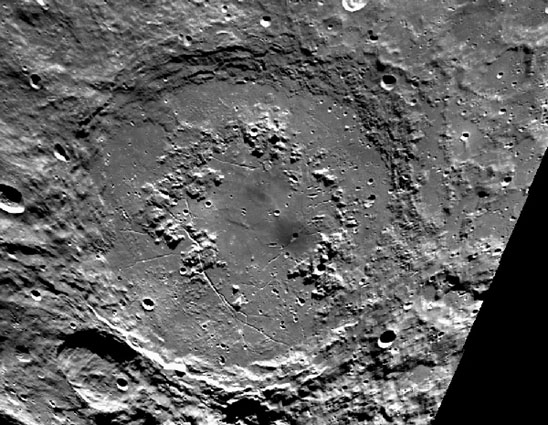August 22, 2015
Schrodinger
Originally published August 22, 2004
Image Credit: Clementine Mosaic - LPI |
|
Schrodinger In 1971 Bill Hartmann and I published a paper on impact basins on the Moon that recognized three types: peak ring basins (like Compton with an inner ring and a central peak), peak ring basins and multi-ring basins, with three or more rings. Ironically, the first two types are poorly represented on the Earth-facing lunar hemisphere and they weren't recognized as a type until we examined farside images. And for some reason, peak ring basins are much more common on Mars and Mercury than on the Moon. The Schiller-Zucchius Basin is the best known peak ring basin on the nearside (and it has an incipient third ring). But a much younger, better preserved and more representative one is Schrodinger, just on the farside of the lunar south pole. As this Clementine mosaic shows Schrodinger is a large (320 km) and complex feature. The arc of mountains defines an inner ring about 155 km wide, and the floor contains a smooth plains material with hills common on the south side. Rilles cut the hilly material and a fresh looking dark halo crater (DHC) occurs on one rille - similar to the relation of DHC and rilles on the floor of Alphonsus. This is one of the larger DHCs on the Moon being 4.8 by 8.6 km wide. In their study of Schrodinger, Gene Shoemaker and colleagues stated that two small, dark and smooth patches of the floor are mare, but that the rest is impact melt. I don't believe that there is significant evidence that the material is impact melt - perhaps it is a non-mare type volcanic material. Crater counts suggest that the basin is essentially the same age as the Orientale Basin (~3.8 b.y), the mare material is ~3.2 b.y and the DHC is <2 b.y. with 1 b.y. being possible. This would be a remarkably young age, far from any other young lunar volcanism. Related Links: Yesterday's LPOD: Vaporum: Crater or Basin? Tomorrow's LPOD: Almost on the Ground |
Author & Editor: COMMENTS?Register, Log in, and join in the comments.
|




